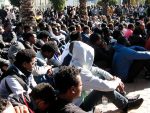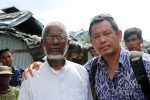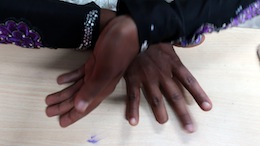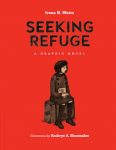Seeking Refuge, written by Irene Watts and illustrated by Kathryn Shoemaker, has been shortlisted for the 2017 Vine Awards for Canadian Jewish Literature. Published by Tradewind Books, the graphic novel is one of the three finalists in the children’s/young adult category.
While this year’s Vine winners will be announced Oct. 3 at a luncheon in Toronto, Vancouverites can meet Watts and Shoemaker later this month at Word Vancouver, and again at the Vancouver Writers Festival in October. The multiple-award-winners, who are both founding members of the Children’s Writers and Illustrators of British Columbia Society, have worked together on several publications, including Good-bye Marianne, a graphic novel based on Watts’ play and subsequent novel of the same name, which also included Shoemaker illustrations.
In Good-bye Marianne, readers meet Marianne Kohn. Set in Berlin in 1938, a week after Kristallnacht, the 11-year-old struggles to understand and cope with the increasing restrictions placed on Jews in Nazi Germany, and the fierce antisemitism she and her family encounter, with a couple of exceptions. The story begins with Marianne not being allowed into her school – all of the Jewish students have been prohibited from attending. As well, her father has disappeared. The situation, as we know from history, worsens, and her mother makes the heartrending decision to send Marianne with “a group of 200 children who are leaving for homes in England,” one of the first groups to be rescued in the Kindertransport.
Seeking Refuge sees Marianne safely to London, arriving Dec. 2, 1938. While protected from physical harm in her new country, Marianne does not escape antisemitism and poor treatment.
In an interview with CBC, Watts commented on Shoemaker’s choice of medium for Seeking Refuge, noting how the grey of the pencil was so well-suited to the story.
“Seeking Refuge is a darker, sadder story, taking place in a time of blackouts, black-and-white films, coal-foggy London, especially the winter months, a gloomy time and place,” said Shoemaker in an interview with the Jewish Independent. “In Good-bye Marianne, Marianne is happier than in Seeking Refuge because she is with family, her home, her country, her language. So, yes, the backgrounds are light, often white. She is anxious about her being sent away but she is not yet sad about it. She is not yet a displaced refugee.”
The possibility of using Seeking Refuge as a way in which to teach younger readers about the current refugee crisis has not gone unnoticed by reviewers and interviewers.
“Stories, in whatever genre, help us to discover more about our place in the world and who we are,” Watts told the Independent. “Immersing ourselves in the lives of fictional characters and their stories, we gain insight of how others live.” While acknowledging that readers will “take whatever message they are ready to understand from the books they read,” she added, “Marianne’s story, though set in the past, is still a familiar one. There are many refugees in the world. Seeking Refuge concerns one child, and how she responds to losing home, friends, family, birthplace, language, culture. In reading about Marianne, a reader may wonder how he would cope in this situation; maybe respond with more kindness and understanding to anyone struggling to make a new life.”
Marianne’s story is similar to – but not the same as – that of Watts, who was educated in England and Wales after her escape from Berlin via the second rescue train in December 1938. Skipping ahead 30 years, she and her husband moved to Canada in 1968, she said, “to give our children a better future.” They immigrated to Alberta.
A playwright and director for Theatre in Education and a drama teacher and consultant in England, Watts taught drama in Hobbema (now Maskwacis), where they lived for a short time before moving to Edmonton. In Edmonton, she was director of Citadel on Wheels and Wings, a children’s touring company that traveled all over Alberta. “We even took our shows to schools in the Northwest Territories,” she said, noting that, among the company’s alumni are Jackson Davies and the late Susan Wright.
“After a few years,” said Watts, “my late husband accepted a position in Vancouver and our four children and I followed. This was in 1976. My base was in White Rock, B.C., and I moved to Vancouver in 2000.”
That Watts likes to write in different genres is clear from the way in which Seeking Refuge came into being.
“Good-bye Marianne began life as a play, which premièred at the Norman Rothstein Theatre in 1994,” Watts explained. “It was produced by Carousel Theatre, and toured widely. It has had many productions, both in Canada and the U.S.A., and will be touring with Theatre New Brunswick for three months in the spring of 2018. I had been a playwright long before I became a novelist. I decided to write the novel because there was still much to say beyond the confines of the play. Kathy Lowinger, then publisher of Tundra Books, rescued the manuscript from the slush pile, and published it in 1998.
“I received countless letters from children, wanting to know what happens next, and so completed both the novel and the play Remember Me, on which Seeking Refuge is based. The trilogy, which ends with Finding Sophie, was later published in an omnibus edition, to commemorate the 75th anniversary of the Kindertransport, as Escape from Berlin.”
For readers anticipating a possible third graphic novel, Watts told the Independent she has “no plans to write about Marianne and Sophie again.”
Shoemaker and Watts collaborated on Watts’ first book for Tradewind, A Telling Time, “which places the story of Queen Esther and the story of Purim in three time frames: modern-day Canada, Nazi-occupied Vienna and the biblical era of Persia. So,” said Watts, “when Kathie told me she had read my play Good-bye Marianne and suggested that it would make an interesting graphic novel, I needed no persuasion, and together we embarked on our next project – a new genre for me. Since then, we have done several other books together, for both Tundra and Tradewind Books.”
A Telling Time, which Shoemaker described as “a picture book for older children about the parallel stories of Queen Esther and how she saves her people and a 1939 secret Purim party,” was recognized by the International Youth Library in Munich, Germany, with a 2006 White Raven special mention.
“For that book,” said Shoemaker, who teaches children’s literature at the University of British Columbia, “I did a huge amount of research. As well, Irene shared many resources with me.
“While I was illustrating A Telling Time,” she said, “I was working on my MA in children’s literature at UBC. Instead of doing an academic thesis, I wrote a graphic novel. During the process of finishing it up, Irene asked me what it was like to write a graphic novel and I told her that, for her, it would be a snap, as it is very much like writing a play or screenplay, as you write primarily dialogue, and, similarly to writing a play scene by scene, a graphic novel is written panel by panel. In response to my answer, Irene told me that Good-bye Marianne had been a play before it was a novel.”
Shoemaker said she drew up several pages of Good-bye Marianne for Watts to send to Tundra as a proposal for a graphic novel. “It was about to have its 10th anniversary, so it was good timing,” said Shoemaker. “Tundra had never done a graphic novel before but they agreed to it.”
Graphic novels were still a relatively new phenomenon at that time. “Other than Chester Brown’s Louis Riel and books for adults, there were almost none,” said Shoemaker. “It was a bit of challenge working with an editor who did not understand the form and also who didn’t seem to understand how closely Irene and I work.
“You will often hear that editors like to keep writers and illustrators apart. I hate that. Irene and I work closely on everything that we do.”
Their creative process begins with Watts writing a rough draft. “She doesn’t number the panels but she describes all the key actions she wants to see occur along with the dialogue,” explained Shoemaker. “From that version, I go back into the manuscript to visualize the sequence of panels. When I do that, I create panel numbers and add in additional panels that may be close-ups, wordless images and additional panels to handle complex conversations. After I’ve done that, I begin a visual dummy, drawing out the entire book panel by panel. When that is complete, I sit down with Irene and go through it panel by panel. As we go through it, we decide what stays, what goes and what more we might need. The best thing about our working together is that we highly respect each other’s ideas and we both listen, consider and change things without any kind of ownership because we consider the work ours. It is our book, not mine, not hers, but ours.”
Watts and Shoemaker will be at Word Vancouver on Sept. 24, 12:45 p.m., at the main branch of Vancouver Public Library in the South Plaza (the Quay) and the Writers Fest on Oct. 18, 1 p.m., at Revue Stage on Granville Island. For more information on both of these festivals and for tickets to the latter ($17), visit wordvancouver.ca and writersfest.bc.ca, respectively.










